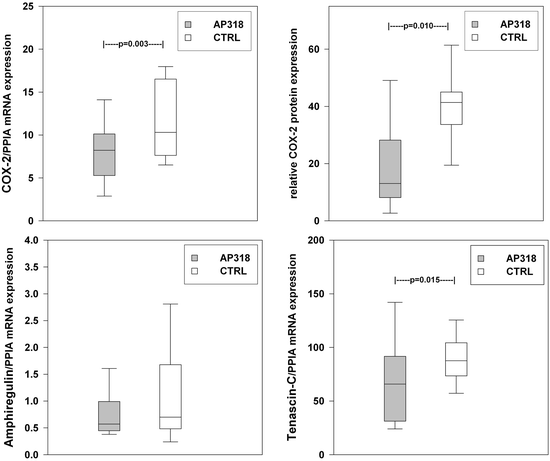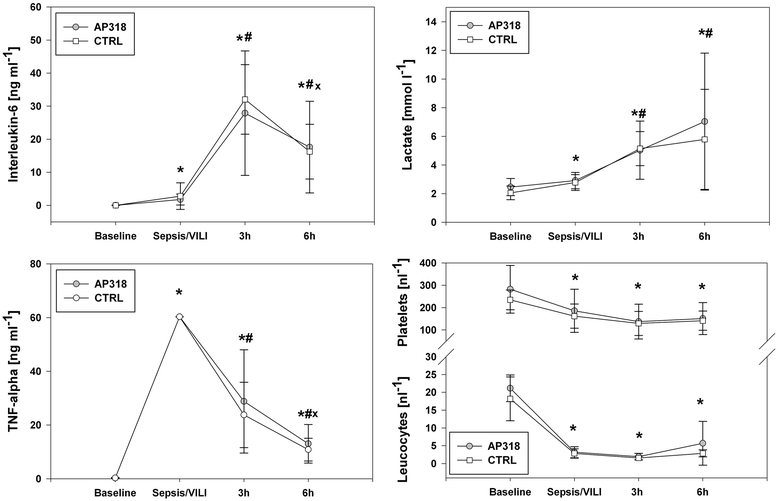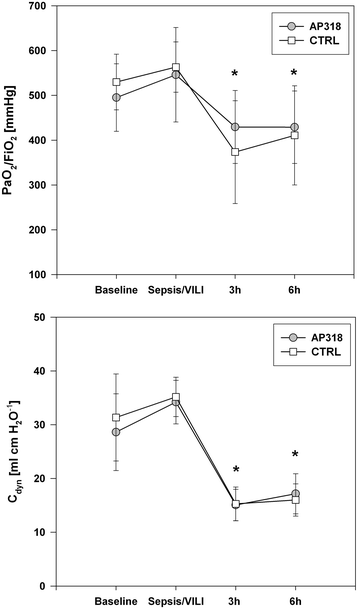Inhalation therapy with the synthetic TIP-like peptide AP318 attenuates pulmonary inflammation in a porcine sepsis model
- PMID: 25879802
- PMCID: PMC4346123
- DOI: 10.1186/s12890-015-0002-6
Inhalation therapy with the synthetic TIP-like peptide AP318 attenuates pulmonary inflammation in a porcine sepsis model
Abstract
Background: The lectin-like domain of TNF-α can be mimicked by synthetic TIP peptides and represents an innovative pharmacologic option to treat edematous respiratory failure. TIP inhalation was shown to reduce pulmonary edema and improve gas exchange. In addition to its edema resolution effect, TIP peptides may exert some anti-inflammatory properties. The present study therefore investigates the influence of the inhaled TIP peptide AP318 on intrapulmonary inflammatory response in a porcine model of systemic sepsis.
Methods: In a randomized-blinded setting lung injury was induced in 18 pigs by lipopolysaccharide-infusion and a second hit with a short period of ventilator-induced lung stress, followed by a six-hour observation period. The animals received either two inhalations with the peptide (AP318, 2×1 mg kg(-1)) or vehicle. Post-mortem pulmonary expression of inflammatory and mechanotransduction markers were determined by real-time polymerase chain reaction (IL-1β, IL-6, TNF-α, COX-2, iNOS, amphiregulin, and tenascin-c). Furthermore, regional histopathological lung injury, edema formation and systemic inflammation were quantified.
Results: Despite similar systemic response to lipopolysaccharide infusion in both groups, pulmonary inflammation (IL-6, TNF-α, COX-2, tenascin-c) was significantly mitigated by AP318. Furthermore, a Western blot analysis shows a significantly lower of COX-2 protein level. The present sepsis model caused minor lung edema formation and moderate gas exchange impairment. Six hours after onset pathologic scoring showed no improvement, while gas exchange parameters and pulmonary edema formation were similar in the two groups.
Conclusion: In summary, AP318 significantly attenuated intrapulmonary inflammatory response even without the presence or resolution of severe pulmonary edema in a porcine model of systemic sepsis-associated lung injury. These findings suggest an anti-inflammatory mechanism of the lectin-like domain beyond mere edema reabsorption in endotoxemic lung injury in vivo.
Figures






Similar articles
-
An amyloidogenic hexapeptide derived from amylin attenuates inflammation and acute lung injury in murine sepsis.PLoS One. 2018 Jul 10;13(7):e0199206. doi: 10.1371/journal.pone.0199206. eCollection 2018. PLoS One. 2018. PMID: 29990318 Free PMC article.
-
Anti-inflammatory effects of novel curcumin analogs in experimental acute lung injury.Respir Res. 2015 Mar 24;16(1):43. doi: 10.1186/s12931-015-0199-1. Respir Res. 2015. PMID: 25889862 Free PMC article.
-
TIP peptide inhalation in experimental acute lung injury: effect of repetitive dosage and different synthetic variants.BMC Anesthesiol. 2014 May 26;14:42. doi: 10.1186/1471-2253-14-42. eCollection 2014. BMC Anesthesiol. 2014. PMID: 24904234 Free PMC article.
-
TIP peptide inhalation in oleic acid-induced experimental lung injury: a post-hoc comparison.BMC Res Notes. 2013 Sep 27;6:385. doi: 10.1186/1756-0500-6-385. BMC Res Notes. 2013. PMID: 24070340 Free PMC article.
-
Dichotomous Role of Tumor Necrosis Factor in Pulmonary Barrier Function and Alveolar Fluid Clearance.Front Physiol. 2022 Feb 21;12:793251. doi: 10.3389/fphys.2021.793251. eCollection 2021. Front Physiol. 2022. PMID: 35264975 Free PMC article. Review.
Cited by
-
Clinical significance and prognosis of serum tenascin-C in patients with sepsis.BMC Anesthesiol. 2018 Nov 15;18(1):170. doi: 10.1186/s12871-018-0634-1. BMC Anesthesiol. 2018. PMID: 30442110 Free PMC article.
-
Oleic Acid-Injection in Pigs As a Model for Acute Respiratory Distress Syndrome.J Vis Exp. 2018 Oct 26;(140):57783. doi: 10.3791/57783. J Vis Exp. 2018. PMID: 30417861 Free PMC article.
-
Considerations for setting occupational exposure limits for novel pharmaceutical modalities.Regul Toxicol Pharmacol. 2020 Dec;118:104813. doi: 10.1016/j.yrtph.2020.104813. Epub 2020 Nov 2. Regul Toxicol Pharmacol. 2020. PMID: 33144077 Free PMC article. Review.
-
Experimental lung injury induces cerebral cytokine mRNA production in pigs.PeerJ. 2020 Dec 9;8:e10471. doi: 10.7717/peerj.10471. eCollection 2020. PeerJ. 2020. PMID: 33354426 Free PMC article.
-
Lung injury does not aggravate mechanical ventilation-induced early cerebral inflammation or apoptosis in an animal model.PLoS One. 2018 Aug 9;13(8):e0202131. doi: 10.1371/journal.pone.0202131. eCollection 2018. PLoS One. 2018. PMID: 30092082 Free PMC article.
References
Publication types
MeSH terms
Substances
LinkOut - more resources
Full Text Sources
Other Literature Sources
Medical
Research Materials

